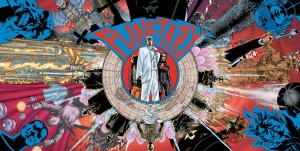It took a while, but we recently finished the first season of Torchwood, the Doctor Who spin-off about a team in Cardiff, England defending the planet against alien incursions, and featuring Captain Jack Harkness, the occasional guest-star of Who. As I’ve done with Who, I’ll list the first season episodes in order of most to least favorite, and as usual my comments below will contain spoilers.
- Captain Jack Harkness (written by Catherine Tregenna)
- Ghost Machine (Helen Raynor)
- Out of Time (Catherine Tregenna)
- They Keep Killing Suzie (Paul Tomalin & Dan McCulloch)
- End of Days (Chris Chibnall)
- Countrycide (Chris Chibnall)
- Random Shoes (Jacquetta May)
- Greeks Bearing Gifts (Toby Whithouse)
- Combat (Noel Clarke)
- Everything Changes (Russell T. Davies)
- Small Worlds (Peter J. Hammond)
- Cyberwoman (Chris Chibnall)
- Day One (Chris Chibnall)
A friend of mine said on Facebook that you have to look at Torchwood as a guilty pleasure. That would be fine – since much of this season is very poorly written – except that I already tend to see Doctor Who as a guilty pleasure, and Torchwood is a big step down from it, so where does that leave it?
The most frustrating thing about the show is that the Torchwood team are mostly incompetent, which is a big change from most shows of this type where the government organization protecting us from the unknown is instead highly competent. But this isn’t really a theme of the show, it’s just a lever used for the stories: The characters are incompetent, so they do stupid things, and that results in problems.
So, for example, in “Cyberwoman”, Ianto has been hiding his half-cyberized girlfriend in the basement of Torchwood since the Battle of Canary Wharf back in Doctor Who season three. He doesn’t really have a plan to reverse her condition, and he certainly doesn’t trust that his co-workers would help him. Naturally it all goes disastrously wrong once she gets loose. Or the first episode, “Everything Changes”, when the characters are making selfish use of the alien artifacts that Torchwood has access to even though Captain Jack’s told them not to. All this would make more sense if the team were more of a research organization, but that’s not really what they do, and it’s certainly not what they’re set up to do. This pattern continues through the season finale, “End of Days”, when the whole team turns against Jack to do something remarkably stupid which puts the whole world at risk. I can’t count the number of times I said, “Maybe next time you’ll listen to Jack!” at the television during the season.
Not that Jack is a whole lot better, since he’s written very erratically. He’s certainly the most competent character in the group (although Tosh is okay; she’s a fair sight better than Gwen, Ianto and Owen), but he also swerves from being empathetic to being very callous and uncompromising. It’s like the writers couldn’t decide if they wanted him to be a tough-as-nails leader, or more of a heroic figure like the Doctor.
The season’s rocky start has one good episode, “Ghost Machine”, and a decent one, “Countrycide”. The former is an atmospheric story about a device that can show echoes of the past, while the latter is a creepy horror story whose punchline is very different from what you’d expect. But neither of these are episodes to build a season on; in a better show, they’d be meat-and-potatoes episodes rather than the standouts. And they’re amidst dumb episodes like “Cyberwoman” or the immeasurably stupid “Day One” with its sex-obsessed alien killer (gah!), or the faerie-inspired but muddily-plotted “Small Worlds”.
The series does get better as it goes on, though. “They Keep Killing Suzie” features the forgotten Torchwood member from the first episode coming back to cause trouble, a well-constructed episode that unfortunately peters out with a pointless chase sequence at the end. “Out of Time” involves some people from 1953 brought forward to the present and having to adjust to a very different era. It’s one of the more thoughtful episodes in dealing with this premise seriously. And the best episode of the season is “Captain Jack Harkness”, in which Jack and Tosh are thrown back to 1941 during the dawn of World War II and have to figure out how to get back even as Tosh is the subject of anti-Japanese sentiment. They also meet, well, Captain Jack Harkness of that era, who’s not at all what they were expecting.
That episode sets up the last episode, “End of Days”, in which the mysterious goings-on turn a promising set-up into the team turning against Jack pointlessly and resolving into another stupid monster story. It’s a bombastic story but it’s frustrating and not very satisfying. And it ends with Jack disappearing to adventure with the Doctor at the end of his third season, which makes the series feel even more like a spin-off which is subordinate to its original series.
Torchwood has all the ingredients to be a solid series, perhaps a little derivative of The X-Files, but with a flaboyant, unusual star character, an inventive visual look to the team’s headerquarters, and an unusual pedigree. But the writing just doesn’t follow through on the series’ premise, and rarely delivers stories that either make much sense on their own terms, or involve characters doing things that seem sensical. Overall, it’s mediocre, and never truly great.

























